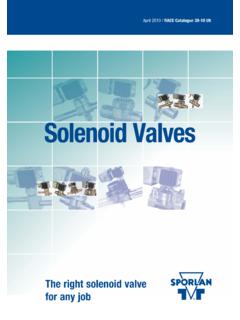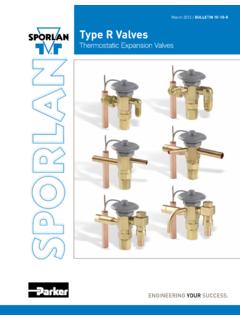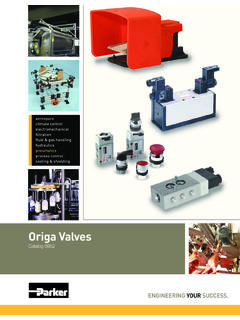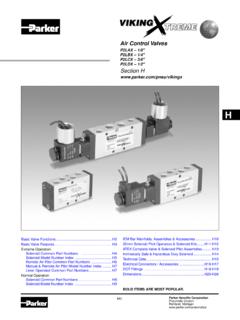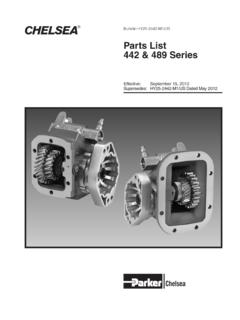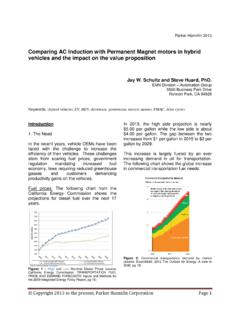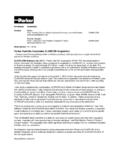Transcription of Thermostatic Expansion Valves - Parker Hannifin …
1 Thermostatic Expansion ValvesWith Selective Thermostatic Charges April 2011 / BULLETIN 10-10 WARNING USER RESPONSIBILITYF ailure or improper selection or improper use of the products described herein or related items can cause death, personal injury and property document and other information from Parker Hannifin Corporation, its subsidiaries and authorized distributors provide product or system options for further investigation by users having technical user, through its own analysis and testing, is solely responsible for making the final selection of the system and components and assuring that all performance, endurance, maintenance, safety and warning requirements of the application are met. The user must analyze all aspects of the application, follow applicable industry standards, and follow the information concerning the product in the current product catalog and in any other materials provided from Parker or its subsidiaries or authorized the extent that Parker or its subsidiaries or authorized distributors provide component or system options based upon data or specifications provided by the user, the user is responsible for determining that such data and specifications are suitable and sufficient for all applications and reasonably foreseeable uses of the components or OF SALEThe items described in this document are hereby offered for sale by Parker Hannifin Corporation.
2 Its subsidiaries or its authorized distributors. This offer and its acceptance are governed by the provisions stated in the detailed Offer of Sale available at 10-10 Page 1t Thermostatic Expansion VALVES10 The Thermostatic Expansion valve (TEV) controls the flow of liquid refrigerant entering the direct Expansion (DX) evaporator by maintaining a constant superheat of the refrigerant vapor at the outlet of the evaporator. The TEV controls the difference between the actual temperature and the saturation temperature of the refrigerant corresponding to the suction pressure at the sensing bulb location; this is superheat. By controlling superheat, the TEV keeps most of the evaporator surface active, while preventing liquid refrigerant from returning to the compressor.
3 The ability of the TEV to match refrigerant flow to the rate at which refrigerant can be vaporized in the evaporator makes the TEV the ideal Expansion device for most air conditioning and refrigeration to Bulletin 10-9 for a complete discussion on The Theory of Operation and Application of Thermostatic Expansion Valves . Refer to Bulletin 10-11 for a complete discussion on Installing and Servicing Thermostatic Expansion OF CONTENTSS election Procedure ..2 Valve Nomenclature / Ordering Thermostatic Charges ..3 TEV Capacity Ratings for Refrigerants: 22, 134a, 401A, 402A, 404A, 407C, 408A, 409A, 410A, 422D, and 507 ..3 Capacity Tables for Refrigerants: 22, 134a, 401A, 402A, 404A, 407C, 408A, 409A, 410A, 422D, and 507.
4 4-8 TEV Quick Reference Guide ..9-11 Valve Specifications F & EF ..15-16 Q, EQ, & SQ ..17-21 BQ, EBQ, & SBQ ..17-21 SBF & EBF ..25-26 EBS ..28 H ..31 M .. 32 V .. 33 W .. 34 Materials and Details of Construction .. 35 OEM Type Thermostatic Expansion Valves .. 36 Terms of Sale with Warranty Limitations .. 37 SELECTIVE Thermostatic CHARGES Designed to provide optimum performance for all applica-tions air conditioning and heat pump, medium and low temperature refrigeration. Thermostatic ELEMENT DESIGNLong lasting and field proven stainless steel diaphragm and welded element construction. DIAPHRAGM DESIGNL arge flat diaphragm permits precise valve control. REPLACEABLE Thermostatic ELEMENTS Field replaceable elements on all standard Valves .
5 ACCESSIBLE INTERNAL PARTS Durable, leakproof body joint construction allows the valve to be disassembled, and the internal parts cleaned and inspected. PIN CARRIER DESIGN (CONVENTIONAL Valves ) Provides precise pin and port alignment, and tighter seating. BALANCED PORT DESIGN Provides perfect pin and port alignment, and prevents changes in pressure drop across the valve from influencing valve operation. Provides excellent control on applications with widely varying operating conditions. MATERIALS OF CONSTRUCTION Pin and port materials offer maximum protection against corrosion and erosion. SILVER SOLDERED CONNECTIONS For leakproof, high strength connection-to-body joints. ADJUSTABLE SUPERHEAT DESIGN All standard Valves are externally Features & Benefits ofSporlan Thermostatic Expansion ValvesFOR USE ON REFRIGERATION and/or AIR CONDITIONING SYSTEMS ONLYB ulletin 10-10, April 2011 supersedes Bulletin 10-10, October 2009 and all prior SELECTION PROCEDUREPage 2 BULLETIN 10-10 The following procedure should be used when selecting a Sporlan TEV:1.
6 Determine the liquid temperature of the refrigerant entering the valve. The TEV capacity tables on pages 4 to 8 are based on a liquid temperature of 100 F for R-22, R-134a, R-401A, R-402A, R-404A, R-407C, R-408A, R-409A, R-410A, and R-507. For other liquid temperatures, apply the correction factor given in the tables for each refrigerant. For example see Table Determine pressure drop across valve. The pressure drop correction factors are based on standard liquid temperature and pressure drop. The standard pres-sure drop is dependent on the evaporator temperature. To determine the pressure drop, subtract the saturated pressure equivalent to evaporator temperature from the condensing pressure. The condensing pressure used in this calculation should be the minimum operating condensing pressure of the system.
7 From this value, subtract all other pressure losses to obtain the net pressure drop across the valve. Use this value to determine the pressure drop correction factor. For example see Table C. Be sure to consider all of the fol-lowing possible sources of pressure drop: 1. Friction losses through refrigeration lines including the evaporator and condenser. 2. Pressure drop across liquid line accessories such as a solenoid valve and filter-drier. 3. Static pressure loss (gain) due to the vertical lift (drop) of the liquid line. 4. Pressure drop across a refrigerant distributor if used. Refer to Bulletin 20-10 for information on refrigerant Select valve from the capacity tables. Select a valve based on the design evaporating temperature.
8 If possible the valve capacity should be equal or slightly exceed the design rating of the system. Be sure to apply the appropriate correction factors for liquid temperature and pressure drop. Once the desired valve capacity has been located, determine the nominal capacity of the valve from the tables second column. On multiple evaporator systems, select each valve on the basis of individual evaporator capacity. For example see Table Determine if an external equalizer is required. The amount of pressure drop between the valve outlet and bulb location will determine if an external equalizer is required. Refer to Bulletin 10-9 for further information on this Select body type. Select the body type according to the style connections desired.
9 For complete specifications on each TEV type including nominal ratings, refer to pages 9 to Select the Sporlan Selective Thermostatic Charge. Select the charge according to the design evaporating tem-perature from the Table on page 3. Refer to Bulletin 10-9 for a complete discussion of the available Sporlan Selective Thermostatic Charges. Selection Example Refrigerant 22 Application: medium temperature refrigeration Design evaporator temperature .. 20 F Design condenser temperature .. 95 F Refrigerant liquid temperature .. 70 F Design system capacity ..1 ton Available pressure drop across TEV: Condensing pressure (psig) .. 182 Evaporating pressure (psig) .. 43 139 Liquid line and accessories loss (psi).
10 4 Distributor and tubes loss (psi) Q .. 35 100 Refrigerant liquid correction factor .. 1 .17 Pressure drop correction factor .. 0 .89 Use the following formula to calculate TEV capacity: TEV Capacity = TEV rating x CF liquid temperature x CF pressure drop EGVE-1 has valve capacity of: 1 .09 x 1 .17 x 0 .89 = 1 .14 Tons at 20 F evaporating temperature, 100 psi pressure drop and 70 liquid temperature . Thermostatic charge (from table on page 3): VC W Selection: EGVE-1-C 3/8 x 1/2 x 1/4 ODF x 5 Q An externally equalized valve must be used on evapo-rators employing a refrigerant distributor due to the pressure drop created by the distributor. In addition, an externally equalized valve should always be used with air conditioning Thermostatic charges to reduce the possibil-ity of Thermostatic charge migration.




